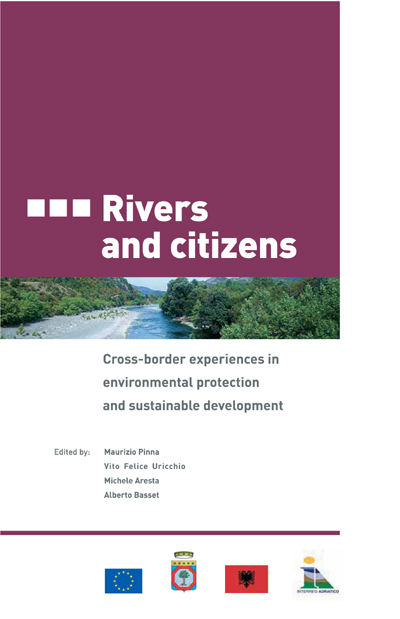
ISBN: 978-88-8305-049-7
e-ISBN: 978-88-8305-050-3
The environment, understood as a complex structure made up of heterogeneous elements, requires holistic approaches that are able to deal with the multiform interactions that regulate the dynamic and evolutionary processes of our planet. Water, in all its forms and in the whole of its cycle, is at the heart of environmental equilibria, as a precondition and as a mediator of life itself, but also as part of the common heritage of mankind and nature. Rivers, whether they are visible, subterranean, or artificial, are elements that connect life, experience and culture, constitute an integral part of our past, and are an essential pre-condition for our future; investment in sustainable development and reconciling issues of economic growth and environmental protection have thus today become a duty which we neglect at our peril. For this reason, Puglia Regional Authority has sought to protect the river Ofanto by setting up the first river park in Puglia, the procedures for which are currently being activated. To achieve this result it is necessary to tackle the water question in context of its environmental, social, cultural, ethical dimensions, placing particular emphasis on the issue of information and education regarding the conservation of our environmental heritage, the historic "memory" of water, and the knowledge and expertise that goes with it. By achieving increasing levels of sustainability, not only does the community gradually reduce its impact on the local and global environment, but it also promotes an increasingly advanced integration of natural ecosystems with socio-economic and cultural life and ever more highly evolved and sustainable equilibria. The results of the research and the experience set out in this volume demonstrate the clear links and interaction between public awareness of natural heritage in terms of aquatic and river environments and human activities, which, if carefully orientated, can lead to advantages and better protection, but can also lead to deterioration and irreversible damage if not managed in an informed way. In the belief that reading this volume can contribute to a better understanding of the complex interactions between the human and the river environment, I invite the reader to draw useful indications regarding how to implement behaviours, actions and strategies that aim to improve the quality of the environment and the ecological value of aquatic ecosystems.
L’Ambiente, inteso come un apparato complesso composto da elementi tra loro eterogenei, richiede approcci globali in grado di cogliere le multiformi interazioni che regolano i processi dinamici ed evolutivi del nostro pianeta. L’acqua, in tutte le sue forme ed in tutto il suo ciclo, è al centro degli equilibri ambientali, come presupposto e come mediatore di vita, ma anche come patrimonio comune per l’uomo e per la natura. I fiumi, siano essi visibili, sotterranei, artificiali o immateriali, sono elementi di connessione di vita, di esperienze e di culture e costituiscono parte integrante del nostro passato e condizione imprescindibile per il nostro futuro, per cui, puntare sullo sviluppo sostenibile e conciliare i temi dello sviluppo economico e della tutela ambientale è oggi un dovere dal quale non è possibile esimersi. Anche per questo la Regione ha voluto tutelare l’Ofanto con la costituzione del primo parco fluviale della Puglia le cui procedure sono in corso di attivazione. Per raggiungere tale risultato è necessario inquadrare la problematica dell’acqua nella dimensione ambientale, sociale, culturale, etica, ponendo particolare riguardo anche alla dimensione informativa ed educativa verso la conservazione del patrimonio, della memoria dell’acqua e dei saperi che l’accompagnano. Pervenendo a livelli crescenti di sostenibilità, la comunità, non solo riduce via via il proprio impatto sull’ambiente locale e globalema promuove una sempre più avanzata integrazione degli ecosistemi naturali nella vita socio-economica e culturale e verso equilibri sempre più evoluti e sostenibili. I risultati delle ricerche e le esperienze rappresentate nel volume evidenziano quanto siano evidenti i legami e le interazioni tra le sensibilità ed i patrimoni naturali espressi dagli ambienti acquatici e fluviali e l’azione umana che, può apportare vantaggi e tutele, se ben orientata, ma può provocare deterioramenti e danni irreversibili se non gestita consapevolmente. Con l’auspicio che la lettura del volume possa contribuire a comprendere le complesse interazioni tra ambiente fluviale ed antropico, invito i gentili lettori a ricavare utili indicazioni per porre in atto comportamenti, azioni e strategie finalizzate a migliorare la qualità dell’ambiente ed il valore ecologico degli ecosistemi acquatici.
| Presentation by the Councillor responsible for the Mediterranean, Puglia Regional Authority |
PDF
|
|
|
5-7 |
| Presentation by the Councillor responsible for Ecology, Puglia Regional Authority |
PDF
|
|
|
9-11 |
| Presentation by the Councillor responsible for the implementation of EU Policies, Lecce Provincial Authority |
PDF
|
|
|
13-13 |
| Management of a river basin: a demo-software for the identification of the potential source of pollutants |
PDF
|
|
Michele
Aresta
,
Angela
Dibenedetto
,
Arcangelo
Di Maggio
|
142-161 |
| Assessment of river quality within the context of the EU's water framework directive (2000/60/EC): the RiverNet Experiences |
PDF
|
|
Antonio
Di Sabatino
,
Bruno
Cicolani
,
Patrizia
Vignini
,
Manila
Pescosolido
,
Francesco Paolo
Miccoli
,
Marco
Giustini
,
Paola
Lombardo
|
162-175 |
Questo sito utilizza un cookie tecnico per consentire la corretta navigazione. Se vuoi saperne di più consulta l'




